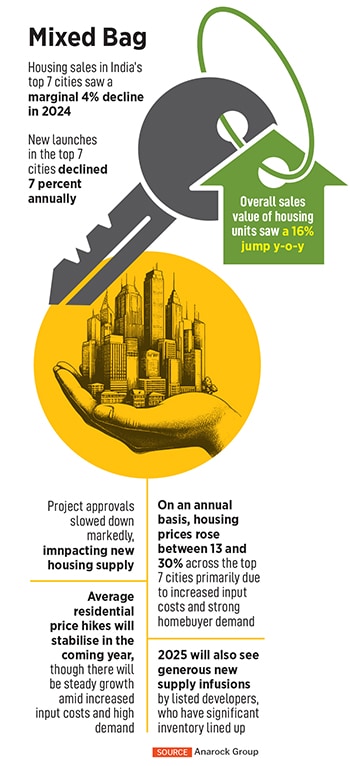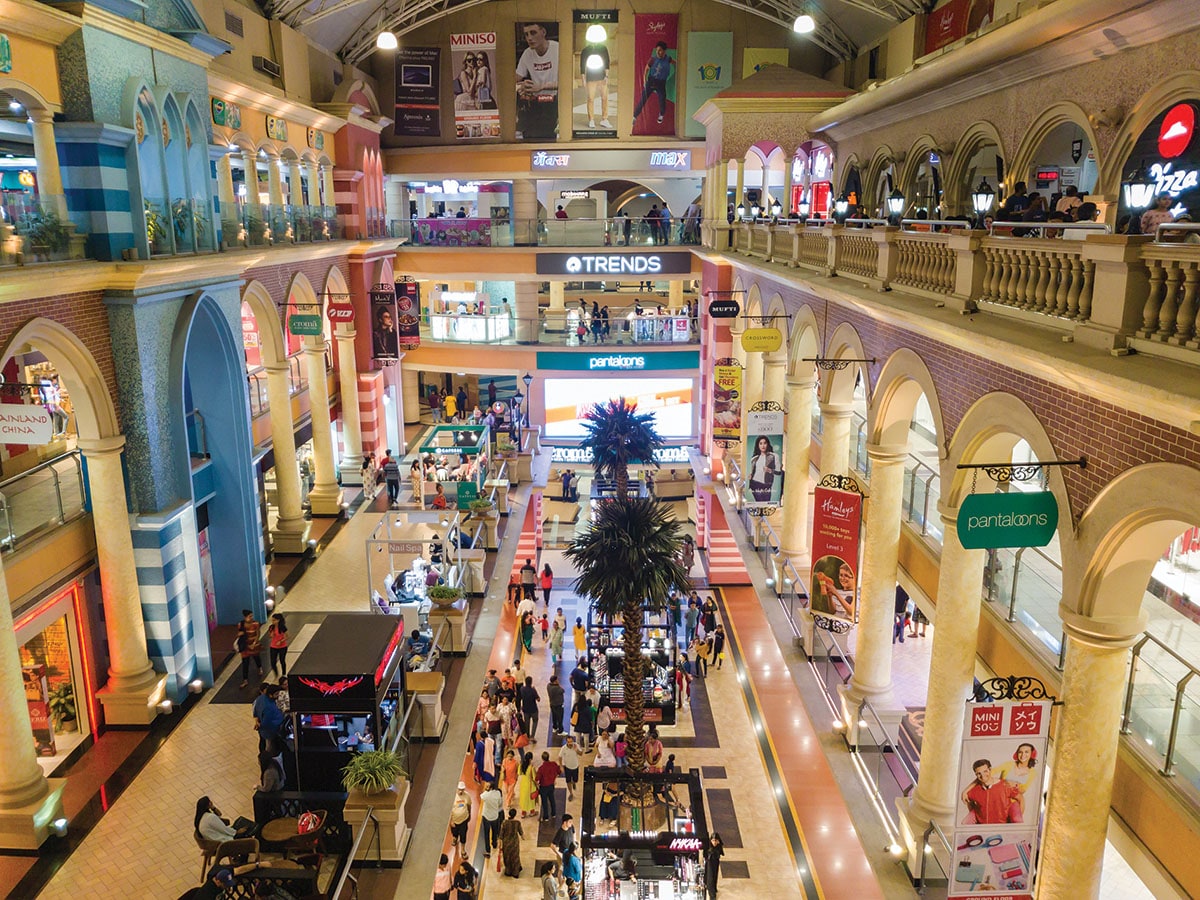These have positive correlations to the Indian real estate industry. An examination of what transpired in the housing and commercial real estate markets in 2024 bears this out.
In the first nine months of 2024, residential real estate sales in the top seven cities rose by 2 percent year on year. According to Anarock Research, there were about 3,57,560 housing units sold in this period. In the correlating period of 2023, approximately 3,49,150 homes were sold. The Mumbai Metropolitan Region (MMR) was ahead of the rest of the top seven cities with approximately 1,20,660 units sold. It was followed by Pune, where 63,180 units were absorbed in the period. Together, the two leading Western cities accounted for over 50 percent of the total housing sales.
Approximately 3,21,780 new homes were launched in the first nine months of the year, which was marginally lower than in the same period in 2023. Nevertheless, this amounted to as much as 72 percent of the total supply witnessed last year. MMR, Pune, and Hyderabad together spoke for 65 percent of the launched units.
 Residential prices across the top cities saw a 23 percent annual increase, largely because of rising input costs and strong demand. Hyderabad recorded the highest surge with a 32 percent hike in housing prices.
Residential prices across the top cities saw a 23 percent annual increase, largely because of rising input costs and strong demand. Hyderabad recorded the highest surge with a 32 percent hike in housing prices.
The demand for luxury (units priced above ₹1.5 crore) and ultra-luxury housing (units priced between ₹10 and 80 crore) grew significantly in 2024, most notably in MMR and NCR. Luxury housing also contributed as much as 28 percent of the new overall housing supply, far outpacing affordable housing at just 19 percent. This trend reflects the increasing desire for spacious, lifestyle-oriented homes in India.
Unsold inventory fell to approximately 5,64,420 units as of the first nine months of 2024, marking an 8 percent reduction since the corresponding period in 2023 and denoting a decadal low. NCR saw the highest decline with an 18 percent year-on-year reduction. Currently, the available housing inventory overhang is at 14 months—a very healthy demand/supply ratio.
The year 2025 holds immense promise for a continued growth trajectory in the country’s residential market. This is borne out by the fact that leading developers acquired a record 1,600 acres designated specifically for the development of housing projects last year. This was a rise of 62 percent over the year before that (2022). This means that 2025 and beyond will see strong new supply infusions. Price appreciation is likely to stabilise between 5 and 10 percent and luxury housing will remain a key price growth driver.
India’s office market has been in rapid recovery after the Covid-19 slowdown. By 2024-end, office leasing will likely exceed 50 million square feet thanks to higher outsourcing work into India and also the Indian BFSI, manufacturing, and flexi-workspace sectors.
Also read: Ultra-luxury real estate: Selling homes that last generations
Global Capability Centres—GCCs—currently account for over 36 percent of leasing activity in India and are the biggest occupier segment. GCC demand will grow in 2025. In fact, GCCs are expected to double by 2030, and this will spark off demand for another 80–100 million square feet of office space.
Flexible workspace players spoke for as much as 22 percent of the overall demand for office spaces in 2024. This stands to reason, since the flexi-workplace market is pegged to expand by as much as 137 percent by 2028, by when it will account for 126 million square feet of commercial real estate.
Sustainability is becoming a major ask in Indian commercial real estate, since an increasing number of both international and domestic tenants now expect to use nothing less than environmentally responsible office assets. A growing preference for a mix of core and flexible workspaces will further fuel this demand.
Retail leasing touched 5 million square feet from January to September 2024 in the top seven cities, driven by domestic retailers and international luxury brands. The fashion, F&B, and entertainment sectors accounted for two-thirds of leasing in 2024, led by Bengaluru and followed by Delhi-NCR and Mumbai.
Grade A malls in prime locations experienced markedly low vacancy rates of 1-7 percent, reflecting robust demand. The growth of retail rentals in cities such as Bengaluru, NCR, Chennai and Pune was between 2 and 5 percent because of increasing sales volumes and rental escalation clauses in leasing agreements. This is boosting the revenues of mall owners significantly.
 Retail leasing touched 5 million square feet from January to September 2024 in the top seven cities, driven by domestic retailers and international luxury brands
Retail leasing touched 5 million square feet from January to September 2024 in the top seven cities, driven by domestic retailers and international luxury brands
Image: Shutterstock
Retailers are determinedly pursuing expansion into Tier II and III cities, eager to break into hitherto untapped or under-tapped consumer bases. Mall developers plan to infuse between 40 and 45 million square feet of organised retail space over the next 4–5 years.
India’s retail market is predicted to reach an overall market value of $2 trillion by 2032 from $690 billion in 2021. The organised retail sector is projected to grow at a CAGR of 25 percent due to the availability of quality new supply and the rising consumption.
REITs have come a long way in India with current REIT office stock estimated to be over 80 million square feet across major cities compared to 25 million sq feet five years ago. Interestingly, the REIT-ready office stock in the country is estimated to be over 500 million sq ft valued at approximately ₹6 lakh crore at a cap rate of 8-8.5 percent. Currently, occupancy levels of the three major office REITs are estimated to be approximately 84 percent.
The SEZ portfolio, however, is operating at a lower occupancy of 64 percent. This is likely to change in the near future as the government has allowed partial and floor-wise denotification of IT SEZs, making it an attractive proposition. Indian REITs and InvITs together have successfully raised investments worth ₹17,116 crore in FY24 compared to ₹1,166 crore in the previous fiscal year.

In 2025, the outlook for Indian REITs remains stable because office leasing picked up significantly across key cities in 2024, particularly by GCC operators. Moreover, many developers have multiple rent-yielding commercial portfolios and will look to tap into the opportunity for more REITable space.
The year 2024 saw the real estate market ramping up its position as one of the cornerstones of the nation’s economy. In housing, the strengthening luxury segment and notable inventory reduction showcase an aspirational middle class and the country’s growing base of HNIs. Commercial real estate has staged a remarkable revival from the pandemic lows, and the continued robustness of India’s retail real estate sector underscores a strong consumption story across the country.
This year remains promising for the Indian housing sector, especially for the premium and luxury housing segments. Commercial real estate absorption will remain healthy even as demand patterns evolve further as coworking and GCCs become the major catchwords. Retail real estate deployment and absorption will continue to prove that the brick-and-mortar story is far from over despite the popularity of e-commerce. Indians will not give up mall visits in favour of online shopping.
In short, the year ahead will see the Indian real estate market script the next chapter of the country’s urbanisation, workplaces, and lifestyle story. When we look back on 2024, we will remember a landmark year for the whole industry.
● The author is chairman and founder of Anarock Group, an international property consultant
(This story appears in the 24 January, 2025 issue
of Forbes India. To visit our Archives, click here.)



 Residential prices across the top cities saw a 23 percent annual increase, largely because of rising input costs and strong demand. Hyderabad recorded the highest surge with a 32 percent hike in housing prices.
Residential prices across the top cities saw a 23 percent annual increase, largely because of rising input costs and strong demand. Hyderabad recorded the highest surge with a 32 percent hike in housing prices.
